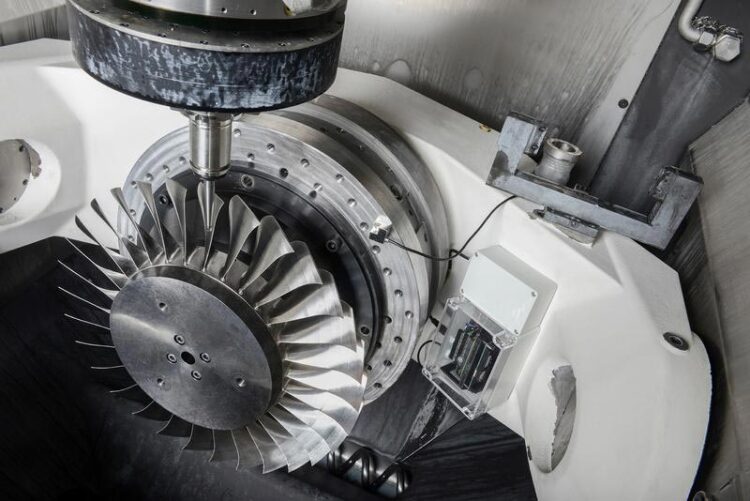Intelligent and flexible 5G edge cloud architecture to control production processes

The 5G Edge Computing Device (right) with vibration sensor, integrated into the BLISK milling process for adaptive control.
© Fraunhofer IPT
Smart sensors that are wirelessly attached to the component, improve the understanding and control of production processes so that processes can be flexibly monitored and adaptively controlled.
What sounds like a far-off vision of the future is already being implemented by the Fraunhofer Institute for Production Technology IPT in Aachen, Germany: Together with seven industrial partners, the researchers have designed an intelligent and flexible process control system that can process large amounts of data and transmit it almost instantaneously using 5G and cloud technology.
Gaining a direct insight into the production process, recognizing maintenance requirements and failure risks in good time, and converting the information into a targeted and adaptive process control system – these are the goals of the “5GSensPRO” research project. One solution promises to be the development of a flexible control system with 5G mobile communications technology for the connection between sensor technology and machine control. The central element is a so-called “5G Edge Computing Device”, a combination of sensor, data processing and radio unit, which is attached directly to the component and integrated into the manufacturing process. The 5G Edge Computing Device is able to process sensor data before it is transmitted and, for the first time, fully connect it to the production machine via 5G. Sensor and machine data can also be accessed remotely via augmented reality visualization using a tablet or smartphone and used for direct quality monitoring.
5G transmission for real-time control of machining processes
The combination of 5G and intelligent sensor technology allows data processing in the millisecond range even for complex movements of the component and machine. The data is already pre-processed in the 5G Edge Computing Device so that only relevant process data is transmitted. In combination with 5G, this not only opens up new possibilities for real-time control of highly dynamic processes. If the data is stored in the cloud, it can be mapped there in the form of a digital twin and included in long-term analyses. This allows the processes to be further optimized in various ways.
An application example: Adaptive control of a milling process in turbomachinery engineering.
The project team tested the function of the 5G-based control architecture using the example of the production of a BLISK component for turbomachinery construction: The 5G Edge Computing Device was mounted directly next to the component. The device records process data such as vibration or temperature directly on the component, processes it itself in advance and sends the “refined” data with 5G in real time to a control unit in the machine cabinet, which monitors and controls the process. For visualization of the manufacturing process, the data is also sent to a local computing unit, the so-called edge cloud, and stored for further data analysis.
This example application shows how 5G can be actively used as a control path for a production process in combination with edge cloud. During the research work in the 5GSensPro project, it was also possible to gain initial experience with the complete and direct connection of a production machine via 5G. “The 5G-based architecture presented exemplifies how decentralized edge components and central cloud systems complement each other in a modular approach. Thus we succeed in making production even more flexible and smarter, as demanded by industry,” says Sarah Schmitt, project manager in the 5GSensPRO project.
The project “5GSensPRO – 5G-based sensor technology for monitoring in production” was funded by the European Regional Development Fund (ERDF) 2014-2020 (funding code: ERDF 0801636).
Partners in the 5GSensPRO project
– Fraunhofer Institute for Production Technology IPT, Aachen
– Marposs Monitoring Solutions GmbH, Egestorf
– Meastream GmbH, Eschweiler
– Oculavis GmbH, Aachen
– QSQ, Erkelenz (associated)
– CP Tech GmbH, Büren (associated)
– Ericsson GmbH, Herzogenrath (associated)
– MTU Aero Engines AG, Munich (associate)
Wissenschaftliche Ansprechpartner:
Sarah Schmitt M.Sc.
Working group »Digital Infrastructures«
Fraunhofer Institute for Production Technology IPT
Steinbachstr. 17
52074 Aachen, Germany
Phone +49 241 8904-782
sarah.schmitt@ipt.fraunhofer.de
www.ipt.fraunhofer.de/en.html
Weitere Informationen:
https://www.ipt.fraunhofer.de/en/Press/Pressreleases/221011-fraunhofer-ipt-devel…
Media Contact
All latest news from the category: Machine Engineering
Machine engineering is one of Germany’s key industries. The importance of this segment has led to the creation of new university degree programs in fields such as production and logistics, process engineering, vehicle/automotive engineering, production engineering and aerospace engineering among others.
innovations-report offers informative reports and articles covering technologies such as automation, motion, power train, energy, conveyor, plastics, lightweight construction, logistics/warehousing, measurement systems, machine tools and control engineering.
Newest articles
Faster, more energy-efficient way to manufacture an industrially important chemical
Zirconium combined with silicon nitride enhances the conversion of propane — present in natural gas — needed to create in-demand plastic, polypropylene. Polypropylene is a common type of plastic found…

Energy planning in Ghana as a role model for the world
Improving the resilience of energy systems in the Global South. What criteria should we use to better plan for resilient energy systems? How do socio-economic, technical and climate change related…

Artificial blood vessels could improve heart bypass outcomes
Artificial blood vessels could improve heart bypass outcomes. 3D-printed blood vessels, which closely mimic the properties of human veins, could transform the treatment of cardiovascular diseases. Strong, flexible, gel-like tubes…





















